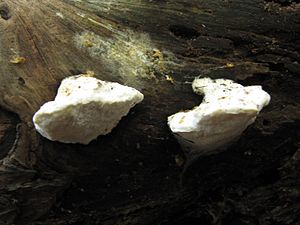Bitter juice porling
| Bitter juice porling | ||||||||||||
|---|---|---|---|---|---|---|---|---|---|---|---|---|

Bitter juice porling ( Amaropostia stiptica ) |
||||||||||||
| Systematics | ||||||||||||
|
||||||||||||
| Scientific name | ||||||||||||
| Amaropostia stiptica | ||||||||||||
| ( Pers. ) BK Cui , LL Shen & YC Dai |
The Bitter Saftporling ( Amaropostia stiptica Syn. : Oligoporus stipticus , Postia stiptica , Spongiporus stipticus , different spelling: stypticus / -a ) is a common fungal art from the family of Stielporlingsverwandten (Polyporaceae).
features
The fruiting bodies are annual. They are 3 to 7 cm wide and 3 to 6 cm from the substrate. Despite the relatively large thickness of several centimeters, the edge is sharply defined. The hats are tinted more or less pure white, but turn creamy to dirty yellow when drying. They show no discoloration when printed. In the process, they harden and their size decreases sharply. The top is barely hairy and often a little wrinkled. When young and in damp weather, milk-white, bitter-tasting guttation drops are deposited on the underside . The taste of the meat ( trama ) is very bitter and astringent .
The spores are 3.5–4.5 × 1.5–2 µm in size.
Species delimitation

The bitter juice porling is characterized by its strong bitter taste, which, however, cannot be perceived by everyone. The gray-white sap spore ( Postia lactea ) is similar , which is mainly found on hardwood and has somewhat narrower, slightly curved spores . The Gloeozystiden-Saftporling ( Fuscopostia leucomallella ) possesses Gloeozystiden .
Ecology and phenology
The bitter sapporling is often found in human-influenced spruce, pine and mixed coniferous forests, especially if these are acidic . It can be found much less often in corresponding near-natural coniferous forests. The fungus is less common in other forest communities.
The species grows in the planar to the montane altitude range . It is rarely found above 1,000 meters . On pines it is mainly found in dry, planar to colline layers. On spruce trees , the area is more likely to be in soil-fresh to moist, sub- to high-montane regions.
The fruiting bodies grow individually or socially to roof tiles on dead trunk bases, stumps and trunks as well as branches. The substrate can be barked or debarked. Mainly coniferous wood is settled, especially spruce . It is rarely found on hardwood. The fruiting bodies grow in summer and autumn from late June to early November. Obsolete specimens can be found all year round.
distribution
The bitter juice porling is common in the Holarctic , where it can be found in the meridional to subboreal areas. It is also found in Argentina, Pakistan, Australia and New Zealand. In the Holarctic, the fungus can be found in North America (Canada, USA), Europe and North Asia (Caucasus, Kazakhstan, Siberia, China).
In Europe it is distributed from Portugal and Spain almost over the entire continent to Central Russia, the Urals and the Caucasus . Only in Ireland, Latvia, Albania and Greece has it not yet been proven. In Germany, the fungus is relatively dense everywhere. The occurrence has increased especially in the last 100 years with the conversion of near-natural forests into coniferous forests.
supporting documents
literature
- German Josef Krieglsteiner (Ed.): The large mushrooms of Baden-Württemberg . Volume 1: General Part. Stand mushrooms: jelly, bark, prick and pore mushrooms. Ulmer, Stuttgart 2000, ISBN 3-8001-3528-0 , p. 559 f.
Individual evidence
- ↑ LL Shen, M. Wang, JL Zhou, JH Xing, BK Cui: Taxonomy and phylogeny of Postia. > Multi-gene phylogeny and taxonomy of the brown-rot fungi: Postia (Polyporales, Basidiomycota) and related genera. 2019, accessed on August 12, 2020 .
- ↑ a b c d Ewald Gerhardt: FSVO manual mushrooms . BLV, Munich 2006, ISBN 3-8354-0053-3 , p. 453 .